#in which Proto Man is a hero
Text

"Mind saying what’s on your mind?"
Siblings on Patrol (Post Become the Night)
#my art#digital art#roll#proto man#met#eddie#support units#comic#megaman#rockman#ruby spears mega man#become the night#recut au#good!Proto au#technically could work for any RS AU tho#in which Proto Man is a hero#but responsibility + domestic life makes him brood#...also would he reprogram Eddie to be less annoying?#...or is that morally kinda awful? idk#I mean RS Eddie is a bit annoying#so understandable but also kinda wrong lol
77 notes
·
View notes
Text
I'm now reading another of Heidi Ann Heiner's fairy tale collections. Sleeping Beauties: Sleeping Beauty and Snow White Tales from Around the World. Since I enjoyed Cinderella Tales from Around the World so much, I couldn't resist opening another of Heiner's books.
The first part of the book is devoted to the different international versions of Sleeping Beauty, the second part to the different versions of Snow White. This is followed by other tales of "sleeping beauties" that don't fit nearly into either category.
We start with the medieval Sleeping Beauty prototype tales from the 13th and 14th centuries.
*The earliest known prototype of the Sleeping Beauty story is the Norse and Germanic legend of Brynhild (a.k.a. Brunhild, Brunhilda, Brünnhilde, or other variations). This legend first appears in the Poetic Edda, the Prose Edda, and the Volsunga Saga from 13th century Iceland. It also appears in the German Nibelungenlied (although that version doesn't include the enchanted sleep), and its most famous modern adaptation is in Richard Wagner's four-opera cycle Der Ring des Nibelungen. The figure of Brynhild also inspired the Marvel superheroine Valkyrie.
**The Sleeping Beauty-like portion of the legend is this. The beautiful and strong-willed Brynhild is one of the valkyries, the warrior maiden servants (and in some versions daughters) of Odin (or Woden, Wotan, etc.) who preside over battlefields and bring the souls of fallen heroes to Valhalla. But Brynhild disobeys Odin by saving (or trying to save) the life of a warrior who was marked for death. (The man's identity, why he was meant to die, why she defends him, and whether she succeeds in saving him or not varies between versions.) As punishment, Odin banishes her to the mortal realm, pricks her with a "sleep thorn," and places her in a castle (or just on a rock) surrounded by a ring of fire, condemning her to sleep until a man brave enough to venture through the flames arrives to wake her and become her husband. (In some versions, she has attendants and servants who all sleep along with her.) Many years later, the fearless hero Sigurd, or Siegfried, succeeds in passing unharmed through the flames and wakes Brynhild by cutting off her valkyrie armor (or in later retellings influenced by Sleeping Beauty, with a kiss). The couple doesn't live happily ever after, however: their further adventures and eventual tragic fates are a story for another day.
**Even though it's a well-known fact that in "the original Sleeping Beauty stories," the prince (or his counterpart) impregnates the sleeping heroine and she wakes after she gives birth, no such thing happens in this earliest proto-version. If we assume that this really is the Western world's first tale of a heroine in an enchanted sleep, then it seems as if that sordid detail was a later addition.
*Next in Heiner's book come several medieval French Sleeping Beauty tales, mostly from Arthurian romances. These are the tales where we first see the motif of the heroine's love interest raping her in her sleep and fathering a child. Since few of them have ever been translated into modern English, the book simply summarizes them instead of printing them in full.
**The best-known of these stories, which most resembles Sleeping Beauty as we know it today, is the tale of Troylus and Zellandine from Le Roman de Perceforest, an Arthurian romance from 14th or 15th century France. In this tale, a knight named Troylus loves a princess named Zellandine. Then learns that while spinning, Zellandine has suddenly fallen into a deep sleep, from which no one can wake her. With the help of a spirit named Zephir and the goddess Venus, Troylus enters the tower where she lies and, at Venus's urging, he takes her virginity. Nine months later, Zellandine gives birth to a son, and when the baby sucks on her finger, she wakes. Zellandine's aunt now arrives, and reveals the whole backstory, which only she knew. When Zellandine was born, the goddesses Lucina, Themis, and Venus came to bless her. As was customary, a meal was set out for the three goddesses, but then the room was left empty so they could enter, dine, and give their blessings unseen; but the aunt hid behind the door and overheard them. Themis received a second-rate dinner knife compared to those of the other two, so she cursed the princess to someday catch a splinter of flax in her finger while spinning, fall into a deep sleep, and never awaken. But Venus altered the curse so that it could be broken and promised to ensure that it would be. When the baby sucked Zellandine's finger, he sucked out the splinter of flax. Eventually, Zellandine and Troylus reunite, marry, and become ancestors of Sir Lancelot.
***This tale provides some answers for questions that the traditional Sleeping Beauty raises. In the familiar tale, the king, the queen, and their court know about the curse, so why do they keep it a secret from the princess? Yes, they avoid upsetting her by doing so, but the end result is that when she finally sees a spindle, she doesn't know to beware of it. Why not warn her? And why is there a random old woman in the castle, spinning with presumably the kingdom's one spindle that wasn't destroyed, and why, despite living in the castle does she not know about the curse? (It's no wonder that most adaptations make her the fairy who cursed the princess in disguise.) Yet in this earlier version, there are no such questions: no one except the eavesdropping aunt knows about the curse, because it was cast in private, so no one can take precautions against it. Another standout details is the fact that Zellandine's sleep doesn't last for many years, and that the man who wakes her already loved her before she fell asleep. Disney didn't create those twists after all!
**The other medieval French Sleeping Beauty tales are Pandragus and Libanor (where Princess Libanor's enchanted sleep only lasts one night, just long enough for Pandragus to impregnate her), Brother of Joy and Sister of Pleasure (where the princess isn't asleep, but dead – yet somehow the prince still impregnates her – and is revived by an herb that a bird carries to her), and Blandin de Cornoalha (a knight who, refreshingly, doesn't impregnate the sleeping maiden Brianda, but breaks her spell by bringing a white hawk to her side).
*All of these early Sleeping Beauty tales are just one part of bigger poetic sagas. Maybe this explains why Sleeping Beauty is fairly light on plot compared to other famous fairy tales (i.e. we're told what's going to happen, and then it does happen, and it all seems inevitable from the start). Of course one argument is that it's a symbolic tale: symbolic of a young girl's coming-of-age, as the princess's childhood ends when she falls asleep and her adulthood begins when she wakes, and/or symbolic of the seasons, with the princess as a Persephone-like figure whose sleep represents winter and whose awakening represents spring. That's all valid. But maybe another reason for the flimsy plot is that the earliest versions of the tale were never meant to stand alone. They were just episodes in much longer and more complex narratives.
@ariel-seagull-wings, @adarkrainbow, @themousefromfantasyland
#sleeping beauty#fairy tale#variations#sleeping beauties: sleeping beauty and snow white tales from around the world#heidi ann heiner#norway#iceland#germany#norse mythology#france#england#italy#tw: rape#tw: cannibalism
38 notes
·
View notes
Note
Could I hear more of your thoughts on Doc Savage and the archetype he created? How does it relate to modern superheroes more specifically Reed Richards? (I know that you dislike Doc Savage, so sorry if this bothers you.)
Sorta like this, if we take a look at how Doc's archetype was formed and consolidated, and how that affected the Superheroes and Reed Richards specifically. (also please don't apologize, you all can ask me questions about whatever, seriously)

"Doc Savage" is recognizable in lots of other characters but there is a difference between specific pastiches or tributes or parodies of Doc (Doc Samson, Edison Rex, Jonas Venture), and characters who are evoking Doc Savage as his own archetype to draw initial inspiration from (Tom Strong, Bane, Clark Kent), and if we pull at Doc's roots we're gonna get to prior characters like Tarzan and Sherlock who were the ones to introduce or codify much of what are now commonplace superhero traits or the ones to introduce much of what Doc was originally pulling from.
I wanna draw some lines in the sand separating what is it that these characters brought to the table, in the road to get to Reed Richards and what exactly is it that Reed and Doc have in common vs things they have that are mainly taken from characters before them/grandfathered in their respective mediums. So let's go over the Archetypes here:
The Sci-Fi Superman: Coined by Peter Coogan. Through some strange birth or scientific intervention, these characters have superhuman powers and abilities that set them irrevocably apart from humanity, nearly forcing them to usually fall into the roles of saviors, rulers, destroyers, or ostracized/self-imposed hermits. Unless they find a purpose requiring said abilites, they cannot be permitted to exist and usually meet a tragic demise or is stripped of said power. Formative example is The Creature from Frankenstein (Mary Shelley), and others include Hugo Danner from Gladiator (Phillip Wylie) and Bill Dunn from The Reign of The Superman (Jerry Siegel). Coogan considers John Carter the first wholly positive and heroic SF superman, which is disputable, but more on Carter later.
Pulp Ubermensch: The Great Man turned do-gooding adventurer with a prosocial agenda. A human who is physically, mentally, and/or morally superior to those around him as a result of training/upbringing, skilled at everything the story requires him to, who applies his talents and abilities near-exclusively to fight evil. Formative example is Nick Carter (created by John R. Coryell and penned by Frederick Van Rensselaer Dey), who established much of what would eventually become pulp hero and superhero convention consequently.
The Great Adventurer: I'm naming these as a counterpoint to The Great Detective, the fantastical globetrotting adventurer/explorer hero who can go anywhere and do anything, who takes to the world as the detective takes to the city. The idea of a wealthy, offbeat, yet good-natured pulp hero who goes around righting wrongs with like-minded assistants. Formative example here is Rocambole (Ponson du Terrail), in most ways a definitive early Pulp Ubermensch, and arguably the first proto-superhero to assemble a gang of odd companions with a variety of talents and backgrounds to aid him, which is what both the Fabulous Five and the Fantastic Four can trace roots back to.
Pulp Supermen: Offshoots of the Sci-Fi Superman as adventure protagonists in serialized stories, where their superhuman natures and status are alleviated and redirected by the need of their capabilities somewhere or in service of something, and thus they get around the ruler/savior/destroyer fate by being heroes with a social calling akin to the Pulp Ubermensch, dedicated to use their powers near-exclusively to fight injustice without rocking the boat of society by their presence (or if necessary, assert dominion ONLY in a setting outside of human society, such as the jungle or Martian civilization). Distinguished from the Pulp Ubermensch by their greater larger-than-life explicitly superhuman abilities, that they don't need to be morally/mentally superior to the extent of a Pulp Ubermensch, and by the fantastical settings and tone of their adventures. Formative examples are John Carter of Mars and Tarzan of the Apes (both created by Edgar Rice Burroughs), with Tarzan quoted by Lester Dent as a specific influence on Doc (there are others but we're skipping most of those not relevant here)
The Science Adventurer: A frequently-used name to describe Doc Savage and Doc Savage-alikes. Doc Savage can be described, in archetype word salad terms, as a Pulp Superman who calls upon the Pulp Ubermensch's great man-ness and urban social calling, and who combines a Sci-Fi Superman origin and physical traits with The Great Adventurer's explorer disposition, righteousness and band of companions. The main thing that sets him apart from the characters listed prior is his focus on scientific prowess, technology, reasoning and polymathic skills, the importance of the "Doc" part of his name as it where.
The Superhero: you already know what these are and how they relate to the above. I've written a couple of things about the differences between pulp heroes and superheroes and it's a subject I'm of constantly mixed opinions on even regarding stuff I wrote, so I'm linking these two written a year apart if you want an idea of where those differences are.
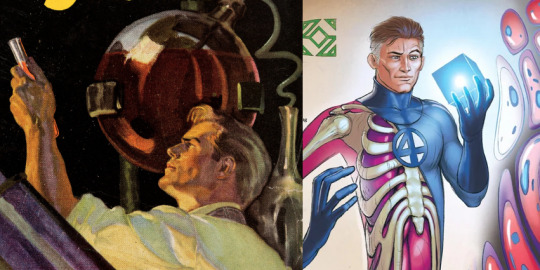
And so we get to Reed, who I'm naming a Science-Adventurer Superhero as a merger of the last two. Both Stan Lee and Jack Kirby mentioned several times that they read Doc Savage aplenty during the Depression and it shows in elements such as the Baxter Building (an expansion of Doc's headquarters in the Empire State Building - instead of just the 86th floor, The Four get the entire skyscraper), the specialized aircraft and vehicles, the fights and antagonism between the cantankerous and anti-social Ben Grimm and the smart-mouthed Johnny Storm mirroring the bickering spats between the bestial Monk and the silver-tongued Ham, and of course Beast from X-Men being more closeled modeled on Monk's ape-ish traits and scientific expertise (there's a fairly large argument to be made, that I think accounts for some of why Beast is, like that, in recent comics, that Ben Grimm and Hank McCoy both divided Monk Mayfair's every trait between themselves and ultimately flipped the script in the long run before taking it to the farthest extremes possible as polarized opposites of each other, with Ben initially getting most of the bad parts and making them the best ones, and Hank initially getting all the good ones and making them into the worst ones)
As far as I know, Reed Richards was not consciously modeled after Doc Savage (although Jack Kirby and Joe Simon's Private Strong used the origin story of a professor raising his son in a lab to be perfect in total isolation of other humans, which Lester likely may have pulled from Phillip Wylie's The Savage Gentleman to begin with), although it's commonly said that the direct precursors of the Four, the Challengers of the Unknown, were modeled after Doc Savage and the Fabulous Five's make-up. The members of the Fantastic Four are all based on 50s sci-fi archetypes, with Reed as the quintessential scientist, the grey-templed pipe-smoking patriarch frontman of the expeditions, and some creators over the years seem to have drawn upon Doc Savage as a model Reed. I'm thinking specifically of Mark Waid here, who openly named Doc Savage in his pitch bible:
The eternal problem with Scientifically Inclined Genius Adventures, the reason they don't ring true, is because in real life scientists spend all their damn time in the lab. Not Reed.
F'r pete's sake, we know he undertook all sorts of Indiana Jones missions as a younger man, we've seen that he actively enlisted in a war, and oh yeah, he stole a rocketship and tried to take it to the moon."
Tommy B put his finger on it when he suggested I stop thinking of Reed as the Professor from Gilligan's Island and instead think of him more like Doc Savage. When Reed encounters mental or logistic obstacles in his quest for knowledge, he thinks through them.
Doc Savage, of course, isn't the perfect model - he's a little more blood-and-gristle than Reed, more invested in the search for justice than for knowledge, and a little more "in the moment" as a general rule. Reed's more like Peter Weller as Buckaroo Banzai, they have the same aloof, detached nature. Unless active danger is staring him right in the face, Reed often seems a bit distant and not completely here because his mind is ten minutes in the future.
That addresses the Science-Adventurer aspect, which leaves us with the Superhero side of the equation.

With Doc Savage you of course have one of the, if not the, main archetypal pulp heroes, a character that both Superman and Batman would take a great deal from, and "pulp hero" in itself is a term that exists to define these characters more so in relation to superheroes than what they were actually like in their own stories, time periods and mediums. The superhero as a concept is founded on Superman and Batman and their dychotomy. Costumed Avenger vs Ubermensch, mortal and immortal, light and dark, Dayman and Nightman (AHH-ahhh-AAHHHHH!), and that dynamic is specifically a result of Superman and Batman being direct descendants from Doc Savage and The Shadow respectively, who were Street & Smith's (and by extension the American pulps) Big Two, the top dogs of 1930s hero pulps, and direct opposites to each other.
Doc Savage was created in response to The Phantom Detective (who was the first successful Shadow imitator and thus defined it as the thing everyone was gonna have to do or respond to) and was in many ways a modernized revamp-almost-copy of Street & Smith's Nick Carter during his heyday, in origin and first case and super strength and omnicapable skills and general Great Man-ness and gadgetry and mission statement and so on. Doc was co-created by the editor of Nick Carter Magazine, John Nanovic, and the first response to the Phantom Detective that S&S planned was a reboot of Nick Carter as a generic hardboiled detective, published on March 1933, the same month as Doc's debut, and obviously Doc would go on to achieve much greater success and thus would popularize those traits again with himself as the figurehead archetype of them (not unlike what Superman and Batman would later do).
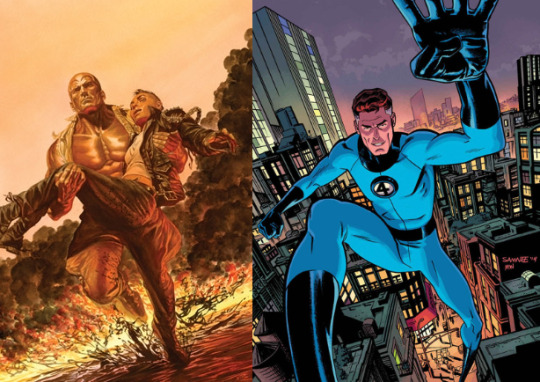
Unlike The Shadow, Doc Savage does not operate under a secret identity or mask. He is not the hidden master of the city and has no division between his alter egos, and because he performs in broad daylight as a celebrity, is theorically held to social scrutiny, and is fully sanctioned and approved by law enforcement and works with the authorities with public transparency (minus the crime college but let's just, not, for now), it greatly upends and affects the approach he takes to fighting crime. He only has one identity, the greatest man of all time as the stories will remind you at every turn, by his author's own words he "manifests Christliness", and while not much separates Doc Savage's skills from Nick Carter's, he is explicitly and textually framed as superhuman (even a "superman", that term was deployed a few times), and he operates in a contemporary, urban setting that most Pulp Supermen cannot touch without veering into Sci-Fi Superman territory.
Within the hero pulp format that S&S started with Nick Carter and renewed with The Shadow, with the scientific explorer angle, you could argue Doc Savage, in almost exactly the same way as he does in his stories, worked out the solution to an unfixable problem: Turns out you can be as over-the-top super as you want, so long as you have a procession of equivalent super menaces to fight, don't upset society (and if you do it, not where the public where can see, keep it a secret that you can be blackmailed over by crooks you will inevitably silence okay look I'll stop now), have whatever incredible miracle cures and achievements and charity you do work on take place off screen where you never have to deal with them too seriously, and know how to pick your fights.
His service to others resolves the ruler/savior/destroyer conundrum. Savage aids individuals who face problems beyond their control, does great work in advancing medicine and science, and alleviates suffering through charity work, but he leaves the institutions of society in place.
He faces a never-ending succession of villains threatening society, an eternal frontier of gangsters and super-scientific menaces who play the role that Indians take in frontier narratives. The unresolvable nature of crime makes this frontier eternal, so Savage can place his superiority in service to the community and never risk turning into a ruler, savior, or destroyer because he can find challenges sufficient to absorb his energies.
The Savage solution—the hero position would be adopted by the creators of other prosocial supermen to come, including Superman, although only the adventures of Superman would be set in contemporary America.
Thus instead of marking an end to the bourgeois domination of society, as Nietzsche foresaw, the superman serves to protect that domination through myth-narratives. - Superhero: The Secret Origin of a Genre, by Peter Coogan

Reed Richards, in turn, is defined (INCORRECTLY, I say, feeling a plasma crackle barely miss my skull) as the smartest man on the planet, a mental superhuman who operates on a level above and beyond that of everyone around him, and a freak accident during a space travel grants him physical superhumanity to match, with his body able to morph and bend under his will. He alleviates the ruler/savior/destroyer conundrum Coogan described in much of the exact same way described above, kept busy with an endless procession of strange dimensions and aliens and supervillain challenges, and Mark Waid's famous confession scene in Fantastic Four #489 addresses the fate that looms over the Sci-Fi Superman directly, with the "very arrogant man who did something very stupid" pointificating to his toddler child just how necessary it was to ensure that the world would not fear and destroy the people he'd irreversibly mutated as a result of hubris, what is even the point of his grandstanding title and colorful outfit and public adventures and all that.

The life of superpowered adventurer celebrities was a necessity, and his superhero persona, Mr Fantastic, is a tabloid-catching act of penitence to mask his ultimate shame and to compensate the people he loves most. He lives for science, he craves discovery above all, but as far back as the Lee/Kirby stories, he still drags the team into awful intrusive press conferences none of them want to go but must, he sits through meetings with hardass generals to buy his team more leeway and trust, he takes the time to stretch across the city to visit sick children in hospitals and say hello to passing helicopters, he has to be the stick-in-the-mud dad who stretches himself thin to keep Johnny and Ben from ditching the team or seriously hurting each other (those first Johnny and Ben spats get way more violent than you'd expect), and he has to make difficult and even manipulative and harsh decisions even then to save the most lives he can. He carries a responsability to his family and loved ones first and foremost, and fashioning himself and them into superheroes is how he lives up to that responsability. It's what allows them to exist and thrive in-universe as much as out of it.
(We're not gonna play catch-up to the "why doesn't Reed Richards cure cancer" conversation but even that, in itself, is an extension of a thread that we can trace back to Doc and the Sci-Fi Supermen before him, when seams in the fantasy start showing with the introduction of consequence, a trend that particularly catches up to these scientist superhero characters who followed in Doc Savage's wake, and obviously caught up to Doc himself several times by now, for reasons @artbyblastweave describes as "a consequence of contemporary writers being Allowed To Notice And Unpack Things" and elaborates on very neatly here)
As a superhero, Reed Richards exists in conversation with Superman and Batman, same as every other character within the superhero "genre", which means he also exists in conversation with those traits borrowed from Doc Savage, and The Shadow, and all these other guys listed who were crucial in their development and a lot of others I'm leaving out of the conversation for now. A crucial part of that conversation and where the Fantastic Four figure into it is the fact that they were designed to not be traditional superheroes but to flip most if not all the conventions established on it's head, a part of that being their initial lack of uniforms (and when they did get uniforms they were just that, uniforms, rather than costumes), the lack of a secret identity, and the fact that the Four are scientists and explorers first, and crimefighting superheroes a distant second they're forced to frequently make a close second or first priority. Marvel made it's big defining pop culture splash with the Fantastic Four by turning superhero convention on it's head and doing as much as they could to do the opposite of what Brand Echh was doing.
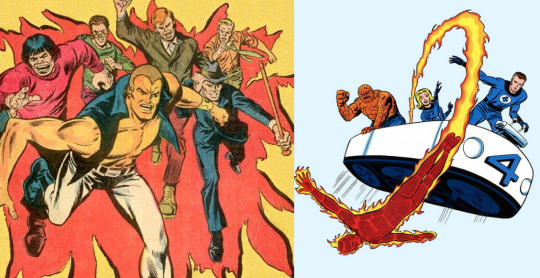
And that's kinda the main reason they end up inviting similarities with Doc Savage and other pulp heroes, because they're going out of their way to imitate and subvert traits and tropes that Superman and Batman were already imitating and subverting from those guys in the first place, that they in turn were imitating and subverting from guys that came before them, and etc.
Archetypes are breakthroughs, and no breakthrough happens in a vacuum. In the end, a lot of these strands and connections between these characters are less specifically the result of writers consciously following in the footsteps of Doc Savage and those that came before or alongside him, and more so with the fact that there's only so many left turns you can take before you just end up in a circle, or reinventing the wheel as it were.

#replies tag#pulp heroes#pulp fiction#superheroes#marvel#marvel comics#doc savage#lester dent#reed richards#fantastic four#stan lee#jack kirby#mark waid#comics
69 notes
·
View notes
Note
Not sure if this has already been asked yet, but how did the team come up with the four love interests in the first place? I feel like the hardest part of developing a character is figuring out how to start. All four feel so wonderfully complex, and are not very "trope-y," which is what I struggle with the most. Thanks!
Aw, thank you! I love answering stuff like this, so I decided to go through my process on Keir and rambled a bit. I'll put my answer under a readmore for brevity.
For us, we started building Obscura with the idea that we wanted to do something dark and mature, and began with developing a setting. Once we picked and started building out the marketplace under the mountain, we could start asking ourselves "why would anyone go to this place?" and work from there. (Vesper's fractum anima is one answer to this question that we really liked for the MC.)
"Thief" feels like a pretty natural role for a marketplace, and Tobi made it clear that she wanted to develop a very dark character, so I thought a more heroic Robin Hood-type character would be a nice contrast. My original concept of Keir was for a thief who burns for justice in a deeply unjust setting; think shounen-anime hero and you're in the right neighbourhood. Pretty tropey, and I say that with love! Proto-Keir would be a delight to write in a different story.
But the rest of the team didn't think that type of character really suited the dark tone we wanted to work with, and they were right. So we took the trope and twisted it. Yes, he's a good man who burns for justice in an unjust world; and he is extremely burned out. And that twist on the formula unlocked Keir for me and the rest of the team. Burned-out Keir could be exhausted and sarcastic and even cynical about the world, bitter about the state of the marketplace and very protective of Mouse Hole as a place he can improve.
This isn't to say that "burned-out activist Robin Hood" is an original characterisation that's never been done before; TV Tropes has a whole page on the Knight in Sour Armor, which deals with similar characters. But it was the foundation we could build on as a team to make a character that felt strong enough to be a romantic interest.
I've mentioned this before, but one of the inspirations I draw from when I write about the marketplace is the awful Web3/crypto environment, a topic I enjoy reading about mostly for the schadenfreude and ended up learning about as a consequence. For Keir, I use concepts like activist burnout and compassion fatigue, things I learned about much more intimately in 2020 (you can guess why). Taking these real life ideas and bringing them into my writing is my favourite way to add depth and texture to characters and settings. If you're looking to do the same, try looking outside fiction and see what things interest you, then bring them back to your fiction.
Not to say that tropey characters are a bad thing! I could write a whole other essay on the utility of character tropes, especially in the world of romance games. Tropes can be a great place to start constructing characters to ensure that they all have their own appeal, and they're just fun to experience as a reader, especially when it's one of your faves. There's no shame in being a bit tropey, if it suits the story you want to tell!
(And if you're looking for a bit of extra ~secret sauce~: give your characters two things they want super badly, but getting one thing will compromise the other. Safety and love are a classic pair; safety often means staying closed off from other people to avoid being hurt, love requires opening up to others. Then let them struggle with those competing wants.)
88 notes
·
View notes
Note
Thoughts on “Man and Superman” by Marv Wolfman?
Countless Superman origin stories, including one written and titled Superman: Year One by Frank Miller himself no less, and this is the only one that thought to copy the actual structure of Batman: Year One.
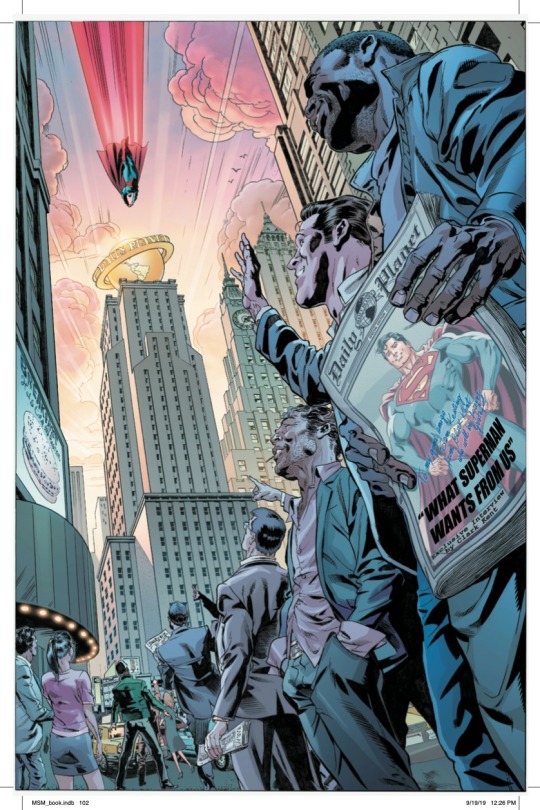
Four issues telling the story of Clark's first year in Metropolis, beginning in Metropolis from the first page. We see Clark arrive in Metropolis, struggle to get a job as a reporter with the major newspapers because he's a nobody from nowhere, wears a "proto-suit" until beginning to wear his classic outfit at the very end, botches his first few attempts at being a hero because he has no clue what he's doing, fall in love with Lois, and ultimately after much trial by fire, become the champion of Metropolis as Superman.
Familiar ground to be sure, culminating as it does in a confrontation with Lex Luthor where Superman promises he will always be around to foil Luthor's plans. If you're a hardcore Superman fan, much of this story will feel familiar to you. Wolfman outright says as much in his introduction, with the long delays this story suffered due to the series it was intended to release under being cancelled, causing similar ideas to be used in other stories. While I can't claim to know who Wolfman had in mind, I definitely saw similarities between his approach to Superman here and how Morrison rebooted him for the New 52.
Even then though, there are some fresh ideas and approaches to be found here that make this take stand out. First and foremost is their approach to the City of Metropolis itself.

This is not the clean Metropolis of Johns/Frank, or the high tech City of Tomorrow of Waid/Yu. Here, Metropolis is gritty, decaying, a City wholly rooted in the problems of today. An upcoming mayor election pits a right-wing candidate who wants to tackle crime with more police officers, vs. a left-wing candidate who wants to tackle the underlying roots of crime. The three janitors Clark works alongside have to work multiple jobs just to make ends meet, and are immigrants themselves also. A crime wave results in marital law, the curbing of civil rights, and the calling of the national guard "for the greater good". Newspapers Clark applies for tell him he needs to sensationalize his reporting more so the story will sell better. This is not a story with a wide-eyed view of what happens in the modern day when the kid from the countryside moves to the big city and tries to make it big. Despite being written in 2008. it could easily have been written today, a damning indictment of American society to be sure. Metropolis here feels real and fleshed out, and while my preference is for a Metropolis that embraces the freedom of being an entirely fictional creation, I appreciate how Wolfman digs into the human element via showing us the viewpoint of the citizens of Metropolis as Clark listens to them with superhearing, casting them as something of a Greek chorus reacting to the events of the story.
Of course not everything is perfect. Wolfman compares Clark becoming Superman to being a firefighter, a doctor, a soldier, and a cop at various points throughout the narrative. The first two I welcome and agree with. Later two however are extremely dicey, and although this is not a story that exempts our modern justice/policing system from a critical eye, (note that the main villain of the story in Lex endorses the right-wing "law and order" candidate to make sure you know which side the narrative supports) it still does not benefit Superman to have his uniform compared to that of a cop's.


As a side note, I love that Clark is explicitly poor here. I love that he struggles to make ends meet, that he's working as a janitor while he tries to make his dream of being a journalist for a prestige news organization come true. Being a cub reporter struggling to get a job, he's not living in a penthouse in the center of Metropolis. Clark is flat out broke, and living in a crappy apartment in the slums of the city. It's an approach that Morrison and Morales used for their Superman reboot, and I support that approach wholeheartedly. Establishing that Clark spent his first few years living in the poorer areas of Metropolis does wonders to support his reputation as the "Champion of the Oppressed".
In flashbacks to his Smallville childhood we see that financial struggles were a factor for him growing up, with Martha wanting to donate money to help feed families in need, while Jonathan was concerned about how tight their own finances are before relenting and agreeing. Of the entire Justice League, Superman is the one who has the strongest claim to being the "working class hero", the blue collar amidst all the blue bloods and middle class suburbanites. Most origins brush over Clark's financial situation growing up, but this one is of the rare few which does not, and I think it's all the stronger for it. Especially so given that this origin is similar to Batman: Year One in that it's really a Year One story for two characters - Lex as well as Superman.
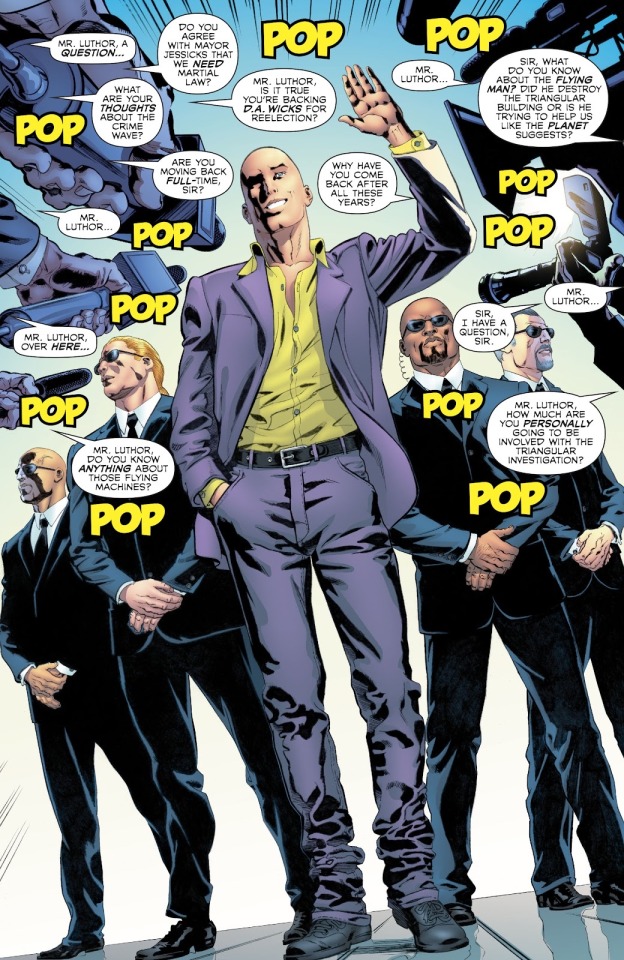
Pitting Superman against Luthor in his first year is old hat, but what I adore about this take specifically is how Lex is explicitly in the "Bruce Wayne" role. Like Bruce, Lex has been gone from Metropolis for multiple years, and makes his return with a plan for reshaping Metropolis in his own image. He's a ruthless monster, willing to kill 500 of his own employees as part of a false flag attack against his own corporate headquarters to garner public sympathy and support. Here the playboy billionaire with a secret agenda and a complete disregard for the law is the villain not the hero. While Wolfman doesn't have the time or pages to dive deep into the rivalry between the two, the class warfare aspect of the feud between Superman and Lex really stood out to me here. Clark lives and works alongside the "little people" and helps them out how he can, meanwhile Lex callously slaughters them in pursuit of his own self-interest.
In the end Lex immediately recognizes that Superman is going to be a watershed moment in history, and is determined to change the world back to when he was on top. I would love a "Year 2" story from Wolfman that skips ahead a bit and pits Lex and another villain against Superman. He has a great handle on the star players here in Clark, Lex, Lois, Perry, and the elder Kents. Give him the Waid treatment and let him build out his own pocket universe if that's something he'd be interested in doing.

Man and Superman has convinced me that if Wolfman had gotten the chance to reboot Superman after Crisis the way he wanted to, I believe the character would have fared far better during the Post-Crisis era. Perhaps it would not have taken the character as long as it did to start putting the Dark Knight Returns stooge interpretation behind him. If this is the only major work Castellini ever does on the character, then I tip my hat to him for a job well done. Not every artist can bring a level of grit and realism to Superman's world without compromising the character, but he managed to pull it off expertly.
24 notes
·
View notes
Text
Looking at the villians they had for My Adventures with Superman,
They honestly picked the best choices they could for a Season 1 rogues gallery.
Think about it (way too much detail below):
They didn't want to dip too far into multiverse and multidimensional villians, outside of Mxyztplk to introduce the concept, so they couldn't pull out Ultraman or Superboy/man Prime (who needs a Crisis Event to even exist properly if they want to do him nicely and that's a whole other can of worms).
They couldn't introduce Kryptonite soon enough for Metallo or Conduit to be relevant, and Metallo also kinda needs Lexcorp to exist beforehand (unless they wanna go with the military origin version who doesn't need Lex).
Conduit also requires an intense murderous rivalry with Clark from Smallville, which how they have made Clark Kent in this iteration, wouldn't make sense. What would he be pissed over, Clark beating him at a chess tournament?!?
Bizarro also comes from Lex's machinations having been a failed clone he created.
Aliens are *not* a common thing known, so intergalactic villains like Darkseid, Lobo, Mongol, and Zod aren't ones to form as threats until Clark knows what Krypton even is, or at least has a vague kind of idea.
We also don't have STAR Labs (yet) and barely have an evil form of Cadmus Labs (sincw they kinds blend in with Task Force X)
Honestly on that front, they did great reworking to have Parasite and Intergang in here as threats, since their origins/threat levels are often tied to Darkseid. Pairing them with Silver Banshee and Ivo were smart in that regards.
And yeah, I can hear the complaints already about Banshee not being a Metahuman and Livewire not being a Shock Jock, but metahumans being a thing not originating from a hush hush experiment from the military (as Episode 9 suggests is happening with Leslie) wouldn't work with how they formed Jimmy's story arc.
On top of that, Silver Banshee was born of magic shenanigans, and introducing that weakness before his more famous one of glowy rock with no known helpful magical allies would have been a major misstep, because that would essentially leave Clark no way to counter and win. She could still mess around with magic angle later in, though, after getting a taste of the power via the tech. (And maybe her sparking a romance with Jimmy, eh?)
As for Livewire not being a Shock Jock, that requires the fact of Superman being previously established as a hero in Metropolis for a time for there to be news about him (and a prominent radio station in Metropolis for Leslie to get zappy-zapped by radio tower after getting fired), which wouldn't work since the show's story makes it clear that Lois and Jimmy are the first ones to encounter him. {Also going the influencer angle wouldn't make sense for her getting electric powers because how would she get zapped while uploading vids on YouTube? Wifi or 5G doesn't work like that.}
Therefore, blending them in with Waller's proto-Suicide Squad of criminals and Sam Lane's distrustful actions against Nemesis Omega all wrapped in a military/government jingoistic bow was a smart move to not make some major potholes for the purpose of story direction. And making them have powers from repurposed Kryptonian tech also equals the unspoken question of "how is Superman constantly getting his ass beat?"
The only other real "Superman" villians they would have room left to mess with would be Toyman, the Atomic Skull, Ultra-humanite, Titano, Chemo, Bloodsport, the Prankster, Volcana (who is barely a villian and is more a victim of circumstance), Mr. Zed, and Manchester Black (depending how they implement them). And we very well may see many of them in Season 2, along with some of the ones from above, now that Kryptonite and the Multiverse exists now and Brainiac and other Krypton survivors have been teased.
They did their best with what they had left to work with, if they wanted to give us the beautiful characterizations and story beats we got in the first place.
Anyway, that's my piece on the villians, why they chose the ones they did, and why they were tech based instead of their other origins, and what ones they could mess with in Season 2 maybe.
Thanks if you read this whole thing, you're a real one for hearing me out.
#my adventures with superman#superman#dc comics#superman rouges gallery#bizarro#lex luthor#general zod#darkseid#toyman#Conduit dc#dc comic villians#livewire#silver banshee#maws#mawsm
47 notes
·
View notes
Text
thinking about how much I hate the kawatche caves subplot again.
first they have clark told that he's prophesised to be a great hero by a native american tribe whose activist leader immediately believes is clark, which is some egregious white saviour bullshit. not to mention the horrid 'both sides'-ing of land rights issues, including have martha kent defend luthorcorp wanting to build an office building on a sacred site because it would be good for the economy.
then they have clark start to doubt and mistreat his best friend because he connects him to the prophecy about his fated enemy. and yeah, lex didn’t care about the caves until he realised their connection to the kryptonian symbols which is the reason he sought conservatorship, and doing so for his own purposes rather than giving it back is bad, no argument here, but then nobody in the show cares about giving the caves back to the kawatche or brings it up as a possibility. after season 3 any connection to native american issues is abandoned and the caves are just treated as a home base for the ai, a proto-fortress and finally a portal to the fortress.
and just like, how any human "usurper" is treated by the narrative is disgusting. like a native american man implied to be a radical activist, who thought he might be the kawatche saviour instead of clark, and is the villain of that episode.
and the way clark always goes back to trusting jor-el/the ai based on nothing? when it had:
brainwashed a scientist, put him into a catatonic state and used him as a vessel to draw clark out, then vaporised him
brainwashed a random teenage girl to think she was a kryptonian, kept her in the cave wall for 14 years and vaporised her the moment she was redundant
tried to kill jonathan
brainwashed clark into his perfect kryptonian heir so he'll take over the world
and then halfway through season 4, jor-el suddenly wants to help clark save the world by keeping the artefacts away from weak human wills? and clark never questions his intentions?? and doesn't care about any of the havoc wreaked on innocent lives the ai did to attract him??? and in season 5 he just decides jor-el was trying to help everyone actually and he should've listened to him.
it's literally so ridiculous.
33 notes
·
View notes
Text
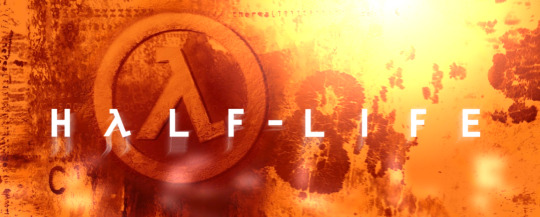
Valve has released a 25th anniversary update for Half-Life.
Half-Life is free to own on Steam until November 20, 2023 10AM PT / 1PM ET.
Overview
BRAND NEW INTERVIEWS
WITH THE HL1 DEV TEAM!
youtube
We got the band back together to celebrate this anniversary, and we invited the fine people at Secret Tape to film it all happening. Getting together after all this time was the perfect opportunity to revisit the game as it existed in its earliest forms, and to talk about how and why it eventually took shape the way it did. Check out the film to see what it was like to be a part of the team, way back then.
THE 25TH ANNIVERSARY UPDATE
FOR HALF-LIFE INCLUDES:
HALF-LIFE UPLINK
Originally released as a CD exclusive for magazines and hardware manufacturers, this mini-campaign was built by the Half-Life team right after the game went gold. As this was many people's first experience with Half-Life, we thought it was finally time to bundle it with the main game—no sound card purchase necessary.


4 NEW MULTIPLAYER MAPS
Built by Valve level designers, these new maps push the limits of what's possible in the Half-Life engine.
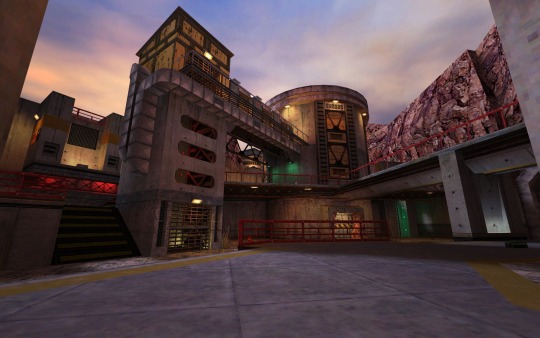
CONTAMINATION
Two-foot-thick steel doors block off access to this contaminated waste facility, which has questionable scientific goals at best. Strap on a gluon gun and roast all intruders.
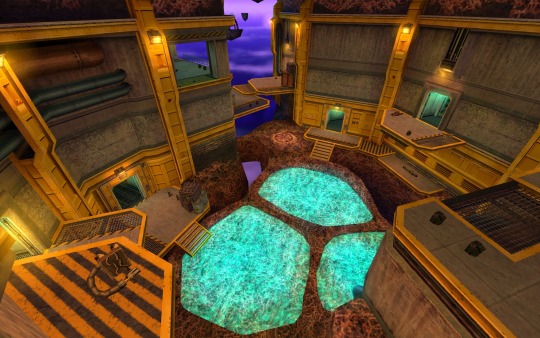
POOL PARTY
Enjoy a relaxing stay at this abandoned Xen outpost built around a cluster of soothing healing pools free-floating in space. How do you breathe here? It doesn't matter!

DISPOSAL
Processing Area 3, a massive radioactive waste plant gone quiet. Tons of room for you and your colleagues to do experiments with a Tau Cannon or some hand grenades.

ROCKET FRENZY
The creaking weight of this decaying orbital satellite launch facility somehow feels familiar… If we could switch on the oxygen lines, power, and fuel, we might just be able to light this candle.
UPDATED GRAPHICS SETTINGS
Play the game the way it looked in 1998, but on a modern monitor.
Widescreen field of view!
Option to disable texture smoothing on the GL renderer!
Lighting fixes including the long-lost GL Overbright support!
Software rendering on Linux! Crisp colors, animated water, and unfiltered textures!
CONTROLLER AND STEAM NETWORKING SUPPORT
A proper gamepad config out of the box!
Added support for Steam Networking! Invite your friends or join games instantly with no fuss.
STEAM DECK SUPPORT!

We finally put our game through our own “Verified” tests, and... we failed super hard. So we fixed it! After re-testing the game, Half-Life gets to officially wear the green checkmark.
Now you can play Half-Life on the best handheld gaming computer in the world in glorious 800p with improved controls and UI.
UI SCALING SUPPORT FOR HIGHER RESOLUTIONS
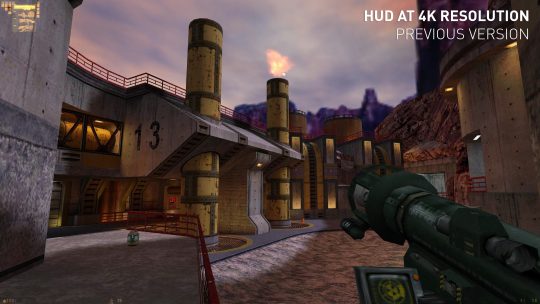

The entire UI has been reworked to scale at larger screen sizes. We built most of this stuff for 640x480 CRTs and apparently some of you have upgraded since then.
RESTORED CONTENT
We brought back the classic Valve logo video with its iconic music and reskinned the menu to match the 1998 build.
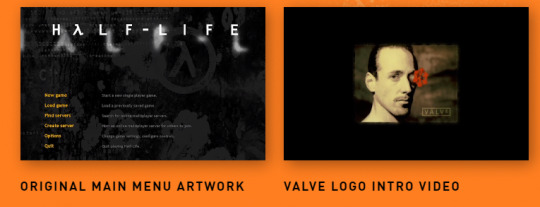
IVAN THE SPACE BIKER AND PROTO-BARNEY

After all this time we finally shipped the original heroes from the alpha builds of Half-Life, available as multiplayer skins!
AS WELL AS THESE RARELY-SEEN EXTRAS!
In 1999, Valve released a CD called Half-Life: Further Data at retail stores, and we're finally including much of that content.
THREE MULTIPLAYER MAPS

Double Cross

Rust Mill

Xen DM
TWO MP PLAYER MODELS

The Half-Life: Further Data CD also included some multiplayer skins made by the original team; we've brought back this incredible skeleton (now with tintable eyes!) and fan-favorite Too Much Coffee Man.
DOZENS OF SPRAYS

While playing a bunch of multiplayer matches we kept wanting more sprays... So we grabbed several megabytes of them from the Further Data release!
BUG FIXES AND CHANGE NOTES
New Content
Now Verified on the Steam Deck (and our native Linux runtime has been set as the default).
Half-Life: Uplink — the original standalone Half-Life demo — has been added to the game, and is accessible through the "New Game" menu.
Added four all-new Half-Life Deathmatch maps: contamination, pool_party, disposal, and rocket_frenzy
Added three old Half-Life Deathmatch maps formerly available only on the "Half-Life: Further Data" CD: doublecross, rust_mill, xen_dm.
Added Ivan the Space Biker, Prototype Barney, Skeleton, and Too Much Coffee Man as player models to Half-Life Deathmatch.
Added dozens of new sprays formerly available only on the "Half-Life: Further Data" CD.
Added support for Steam Networking, allowing easy multiplayer via Steam's Join Game and Invite features.
Added support for Steam Friends Rich Presence, allowing your friends to follow your journey through Black Mesa.
Nostalgia
Brought back the original Valve Intro video. Can be skipped with the "-novid" launch command.
Updated main menu to a design inspired by the game's original 1998 main menu.
Changed the default models to the original (non "HD") models.
Gameplay Changes
Improved physics for throwing grenades.
Improved randomness for initial spawn points in multiplayer.
Improved satchel charge controls: primary fire now always throws a new satchel, and secondary fire always detonates.
Fixed push-able entity movement being based on framerate.
Fixed players with high framerates freezing in place on death in multiplayer.
Fixed some cases where the player could get stuck in place on level transitions.
Fixed some cases where characters would interrupt important dialogue with their "greetings" dialogue.
Fixed weapon view-bob angles.
Fixed red barrels at the start of Surface Tension not launching as intended.
Fixed Snarks attacking FL_WORLDBRUSH entities (such as func_walls).
Fixed players sometimes failing to deploy a snark while crouching and looking down.
Fixed certain convars ("pausable" and "sv_maxspeed") being set to incorrect values when entering a singleplayer game after a multiplayer game.
Fixed singleplayer auto-aim setting being changed when entering a multiplayer game that disallows auto-aim.
Fixed the flashlight HUD showing empty after loading a savegame.
Fixed rockets in CONTENTS_SKY not always detonating.
Fixed incorrect bullet impact sounds for NPCs.
Fixed gauss gun making a loud static noise if it was charged across level transitions.
Fixed a crash in mods that display keybinds in their UI.
Fixed singleplayer weapons not auto-switching away when exhausted (grenades / snarks / satchels / etc)
Fixed interpolation artifacts when animated models are moved by other entities.
Fixed some buffer overflow exploits.
UI Changes
Main-menu background and buttons have been reskinned, and now scale based upon screen resolution without stretching, supporting background image layouts up to 3840x1600.
In-Game HUD now uses double or triple sized sprites when playing at higher resolutions.
UI dialogs and in-game fonts now scale to improve readability at high screen resolutions.
In-Game HUD HEV suit display has been shifted to the left of the screen, and no longer changes position at larger screen resolutions.
Added an "Enable texture filtering" setting.
Added an "Allow widescreen Field of View" setting to correct non-anamorphic FOVs, for widescreen and ultrawide displays.
Re-organized all the Settings screens to improve legibility, and support controller navigation.
Updated the Pause menu to be aware of the current gameplay mode.
The default server name and multiplayer player name are now based on the player's Steam Persona.
The Steam platform menu has been removed, now that all its features are in Steam itself.
Fixed application icon rendering incorrectly when using the software renderer.
Fixed player and spray images not updating their coloring on the settings screen.
Removed the now very unnecessary "Low video quality. Helps with slower video cards." setting.
Input Changes
Improved support for keyboard and controller navigation everywhere.
Added "Lower Input Latency" option: Synchronizes the CPU and GPU to reduce the time between input and display output.
Fixed issues that caused jerky mouse / joystick input.
(We basically rewrote it all - if you've got a custom Steam Input controller configuration, you should rebuild it from our newly published Official Configuration).
Multiplayer Balancing
Increased the 357 damage from 40 → 50.
Hive Hand reload time has been reduced from 0.5s → 0.3s per shot, and it will be selected at higher priority than the pistol on pickup.
MP5 now always starts it with full ammo when picked up.
Players no longer drop empty weapons, and any that are dropped are reloaded by what's in the dying player's backpack.
Improved client-side prediction to reduce "ghost shots". Like Counter-Strike, consider hitboxes and not just bounding boxes for hits on the client.
Fixed network predicted crowbar swing damage being incorrect.
Rendering
Added supported for UI Sprites and Texture files larger than 256x256.
Added support for UI Font special render modes: "blur" and "additive".
Added setting to turn off texture filtering when using the OpenGL renderer.
Default resolution is now based on the resolution of the desktop, instead of a 640x480 window.
Default gamma has been decreased from 2.5 → 2.2, now that we aren't all playing on CRTs.
Software renderer will now correctly filter out incompatible resolutions, unless there is only 1 resolution available on the display.
Restored OpenGL overbright support.
Fixed fullscreen software renderer crashing on systems that don't support 16-bit color.
Fixed software renderer being stretched when using widescreen resolutions.
Fixed skyboxes and sky color incorrectly carrying over when transitioning maps in multiplayer.
Fixed the game appearing too dark after modifying video settings.
Fixed MSAA in windowed mode.
Fixed mipmap rendering on studio models.
Fixed gluon gun sprite rendering in multiplayer.
Fixed gluon gun sinusoidal noise being incorrect.
Various optimizations to support the newly increased engine limits.
OpenGL optimizations for the Steam Deck.
Engine Improvements for Mod Makers
Increased maximum limit of dynamic sound channels from 8 → 32.
Increased maximum limit of sentences in the sentences.txt file from 1536 → 2048.
Increased maximum number of entities (MAX_EDICTS) from 900 → 1200.
Increased MAX_PACKET_ENTITIES increased from 256 → 1024.
Increased MAX_GLTEXTURES from 4800 → 10000.
Increased software renderer geometry limits: max spans 3000 → 6000, max surfaces 2000 → 4000, and max edges 7200 → 14400.
Cycler and func_button entities can now be the entity target for scripted_sentence entities, and are allowed to speak in multiplayer.
Incorporated func_vehicle entity support from Counter-Strike, for mod-makers to use. Full SDK update will come later, but level designers can use it now.
Native Linux Build
Added support for the software renderer.
Improved font rendering.
Many stability and behavior fixes.
Other
Localization files updated.
Miscellaneous security fixes.
Notes
The previous version of the game has been archived to a publicly visible Beta branch named "steam_legacy", with the description "Pre-25th Anniversary Build." If a mod or feature is behaving in an unexpected way, you may need to run this archived build until the issue is resolved in the default build.
We now consider this anniversary version of Half Life to be the definitive version, and the one we'll continue to support going forward. Therefore, we'll be reducing the visibility of Half Life: Source on the Steam Store. We know Half-Life: Source's assets are still being used by the Source engine community, so it'll remain available, but we'll be encouraging new Half-Life players to play this version instead.
WALLPAPERS
Celebrate 25 years of Half-life by decorating your desktop and mobile phone.

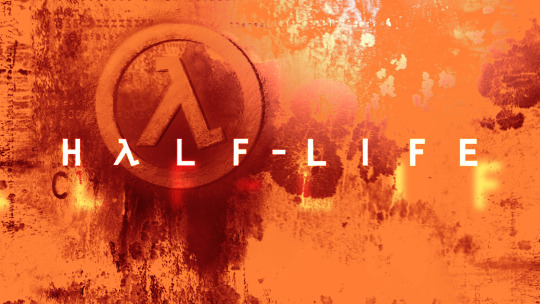






32 notes
·
View notes
Text
The Etymology of Finnish NHL Players a.k.a What Do Their Names Mean?
PACIFIC DIVISION 2023-2024
ANAHEIM DUCKS
URHO VAAKANAINEN
URHO /ˈurho/
A Finnish name derived from a Proto-Finnic word meaning ”man”. A poetic Finnish word meaning ”hero”.
VAAKANAINEN /ˈʋɑːkɑnɑi̯nen/
A Karelian surname based on several Orthodox given names derived from the Greek name Bakchos, meaning ”to shout”. A Finnish homonym for ”scales woman”.
SAN JOSE SHARKS
MIKAEL GRANLUND
MIKAEL /ˈmi.kɑ.el/
Derived from the Hebrew name Mikha’el, meaning ”who is like God?”.
GRANLUND /ˈɡrɑːn.lund/
A topographic Swedish surname meaning ”spruce grove”.
KAAPO KÄHKÖNEN
KAAPO /ˈkɑː.po/
Derived from the Hebrew name Gavri’el, meaning "God is my strong man”.
KÄHKÖNEN /ˈkæh.kø.nen/
A Savonian and Karelian surname possibly derived from the Finnish word käheä, meaning ”hoarse”.
SEATTLE KRAKEN
EELI TOLVANEN
EELI /ˈeː.li/
Derived from the Hebrew name Eli, meaning ”ascension”.
TOLVANEN /ˈtol.ʋɑ.nen/
A Savonian and Karelian surname possibly based on a given name derived from the Old German name Adalwolf, meaning "noble wolf”.
NOTES:
During the 12th century, the tradition of Finnish given names was lost due to the Christianization of Finland under the Swedish rule. By the 16th century only Christian names were accepted, which is why Finnish forms of Christian names are still widely popular in Finland despite the society being fairly secular. The tradition of native Finnish given names wasn’t revived until the 19th century.
Most Finnish surnames end in suffixes -nen or -la/-lä. The collective suffix -nen, which is more common in Eastern Finnish surnames, indicates belonging to a certain family or clan. The suffix -la/-lä, which is more common in Western Finnish surnames, creates oikonyms from the names of places, farms or small villages.
Karelia and Karelian can be used to refer to a geographical place, language, dialect or people. It is important to note that Karelian is its own language separate from Finnish. However, the Finnish language also has a Karelian dialect that is spoken in the Finnish Karelia. Finnish surnames originating from Karelia have likely been influenced by both Karelian and Finnish.
The IPA forms follow Finnish phonology even with foreign (Swedish, Russian etc.) names in approximation to how an average Finn pronounces them.
The source for most of the given names is Behind The Name. The topographic surnames are direct translations. The explanations for the rest of the surnames are either from Finnish Wiktionary or based on speculation by Finnish genealogy enthusiasts, hence the overuse of the word "possibly".
Feedback is welcome. If you have additions or notice any mistakes, please let me know!
#anaheim ducks#san jose sharks#seattle kraken#me thinks pacific might be a little biased against finns. at least central loves us </3#bit sad that vaakanainen's zodiac sign isn't libra. cause it'd be funny#etymology#should've posted these before the trade deadline but alas
11 notes
·
View notes
Text
The thing about The History of Tom Jones, a Foundling (1749) is that it is fundamentally about women’s desire. I’m not saying that I like everything that Fielding has to say about women’s desire, or that his own obsession with women’s sexuality isn’t baldly plain on the page. It is! It definitely is! For every one of his culture’s biases about women’s sexuality that he aims to deconstruct, there are several more of his own that remain unexamined. It’s one of the knottier (and perhaps more compelling) parts of the text as a modern reader — to observe how these sort of proto-feminist threads are at tension with the lazy misogyny still on the page.
However, it is undeniably the female characters' desires that shape and propel the narrative, so it’s very interesting to see how modern readers who have never read the book or have only learned about aspects of it through osmosis apply a knee-jerk assumption that it’s Tom’s desires that are shaping the story. They know it’s about a man who sleeps with several women, so therefore Tom must be a seducer, a womanizer, a rake, a playboy, or even a rapist. When in fact, it’s a central conceit (if not THE central conceit) of the novel that Tom is never interested in a woman who isn’t interested in him first. The romance begins when Sophia decides she wants Tom, not when Tom decides he wants Sophia.
There’s certainly a lot to unpack in the fact that Fielding wrote an 1000-page novel about horny women lusting after his hero, but in as much as it’s possible to back something like that up, he does back it up. Women don't just like Tom because he's attractive, they like him because he’s genuinely good with women. He actually likes women, he enjoys spending time with them in both sexual and platonic contexts. He feels safe to be around because it's not his default mode to objectify women -- he literally never once considers sleeping with a woman until she has already propositioned him. He regularly leverages his privilege to defend and advocate for women who others around him have decided are worthless and maintains positive feelings towards his partners after their sexual relationship has ended. He remains friends with his ex-girlfriend Molly for the rest of his life!! He is -- literally -- the definition of a himbo in its truest form.
Anyway, I'm just really grateful that Gwyneth Hughes and Georgia Parris both understood this about Tom as a character and understood the opportunities in the text for actively centering the women -- giving the voice of the story to Sophia and adding much needed roundness and complexity to the other female characters on the page. It's really what I've always wanted for this book. Of course the story still has issues, some of which are baked in, most notably the execution of the HEA and how it requires Fielding to uphold the systems he's spent the novel critiquing (but that's a different essay.) But at the end of the day, I love these characters so much and it's just nice to read interviews with Hughes where she makes it clear: "I didn't update Tom. This is Tom."
#tom jones#the history of tom jones#henry fielding#tom jones pbs#tom jones 2023#gwyneth hughes#tom jones meta#i wrote this post in the green room before my gig last night akljdhfasfas#i just have so many feelings#tom my boy my actual son and heir
63 notes
·
View notes
Note
Read your post on "disruptors", loved it, and made me wonder why so many have a cult of personality spring up around them. Were there similar cults of personality for the mega wealthy in the past; like was Rockefeller worshiped the way so many worship Musk? Or is it a more modern trend fuelled by our constant connectivity and consumption of media? Thanks!
You raise an interesting question.
It was certainly true that the robber barons of the 19th century - Vanderbilt, Rockefeller, Carnegie, Morgan, Gould, Frick, etc. - were larger-than-life figures in the media (especially the part of the media that covered high society). It is also true that with a lot of these figures, there was this popular myth of the self-made man that sought to turn them into quintessential rags-to-riches, up-by-your-bootstraps American sucess stories.
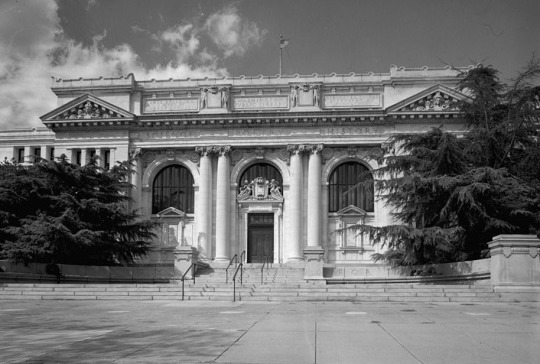
But for the most part, the robber barons of the Gilded Age were hated for their monopolistic behavior and their use of violence to suppress the working class - and these magnates often had to go to great lengths to repair their reputations. Andre Carnegie's library-building campaign, for example, was very much a PR move meant to soften his image after the Homestead Strike. In fact, my great-grandfather Humphrey Attewell helped to organize opposition to the construction of a Carnegie library in Northampton, because he and other working-class people felt that the funds for the library were blood money distributed by a murderer. Likewise, it's not an accident that John D. Rockefeller founded the Rockefeller Foundation right around the same time that the Ludlow Massacre turned him into a monster in the eyes of the American public.
I would argue that we start to see more of a cult of personality around the mega-wealthy a bit later - say, 1900s-1930s - and the major turning point was the career of Thomas Edison. While Edison was every bit as ruthless and grasping as the robber barons before him - hence the war of the currents, his penchant for patent theft and/or stealing credit for inventions, the very existence of Hollywood - the fact that he was an inventor with so many world-changing patents to his name made Edison into a very different kind of media figure. Thomas Edison became a star of pulp fiction and dime novels, a sort of proto-superhero Science Hero - in addition to Edison's Conquest of Mars (an unauthorized sequel to the War of the Worlds in which Thomas Edison gets revenge for the Martian invasion of Earth by launching a counter-invasion of the red planet with his superior technology), there was a whole genre of Edisonades all about young inventor geniuses who use their inventions to save the day and/or explore the "savage frontier."

I think you can draw a line from the cult of personality around Edison to the cult of personality that formed around Henry Ford in the 20s and 30s as not just a car manufacturer but a visionary who had created a new age of modernity, and from there to the legend of the Packard garage, and from there to contemporary Silicon Valley.
56 notes
·
View notes
Text
I think it's really important to distinguish that even a light side romanced-the-Exile Atton isn't motivated by goodness for its own sake. He has a stronger sense of responsibility than before, yes, and he'll get involved when the whim strikes him - and a light Atton will have more of those occasional chivalrous, or maybe just cocky, impulses than the keep-your-head-down man he was at the start of the game.
But he's still a scoundrel by nature, horribly jaded, very comfortable with problem-solving via murder, and he believes in neither the Jedi Code nor the pursuit of atonement. His morality is more Exile-centric than anything else, as in “I'm going to do this to protect them” or “I guess I'll do this stupid dangerous thing because they'll think I'm cool.” Love doesn't make Atton a better person, but it puts him through the motions (and if reciprocated, it'd make him a happier one, which would at least improve his behavior a bit.)
All in all, it's something where I think the game's alignment system can be misleading. People look at Atton mirroring the PC's alignment with that big beam of light behind him and go “he's a good guy now!” But nothing in-game really supports that. Does he approve of a LS Exile's actions? Yes, even if it confuses him and he's tsundere about it. Would he do the same thing in their shoes? Nope – that's why he's so inspired by them. Because they went through the same shit he did and still held onto the things he couldn't. Because he fought alongside Jedi in two wars, watched the pacifists cower as the galaxy burned and watched the war heroes turn into psychopaths, and he doesn't trust it at first, but this carved-up shell of a Jedi, the one who pulled the plug at kriffing Malachor V, is the closest thing he's ever seen to what the Jedi were supposed to be. Atton's portrait is gonna be pretty dang light sided while he's ranting at your Exile that all the Jedi who died on Malachor deserved what they got, and he means what he's saying. The game can stick him wherever on that bar it wants, but it's not serenity and goodwill that fills him, it's a messy morass of poison he's been choking down for years.
His arc is more about ceasing to run from himself, sorting out his feelings and his fears, and finally being able to move forward than it is about redemption. You figure he already had his big worldview shift years ago and made zero attempt to make up for any of what he did or mirror the grace he was shown, and, like... Atton's motivations start and stop with the Exile. Everyone else in the party has some other allegiance or some further goal that shapes their path. Bao-Dur wants to rebuild the planets destroyed in the war. Mira wants to reunite the families it broke. Atton wants to help the Exile, and if they're a lady, he wants to get together with her. That's all he wants out of life... unless he goes dark side, which gets ugly real fast.
While a dark Atton crashes straight back down to the bottom of the bar, I think the lightest Atton realistically gets is the grey background with a dusting of blue at his feet. It's like Kreia says – his potential lies downward. Dark Atton is terrifying, a proto-Sion, a hollowed-out obsessive shell of a man who can only feel anything through tearing Jedi down to his level. Light Atton is just a guy.
It's for this reason that I have trouble seeing him helping to rebuild the Jedi Order as canon implies. He never stopped hating the Order, and he has no stake in it anyway, only you – heck, if you look at becoming a Jedi as the pivotal moment in all of the Lost Jedi character arcs, Atton's decision to become a Jedi is so he can better protect the Exile. It's only a personal choice inasmuch as he's decided this is how he can live with himself, offering his life to someone who's truly proven to him that they're worth it. He's got nothing else anchoring him, to the point where I think he really is better off with the Exile than left to his own devices, even accounting for the influence warp and the probable imminent death. And I think it's telling that Kreia will only predict his future when he has motivations that don't include the Exile.
65 notes
·
View notes
Text
Orpheus and the Katabasis
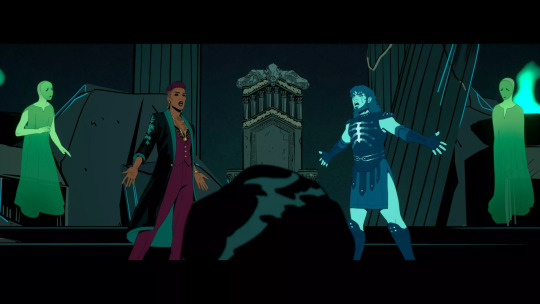
Another topic for mythologic geekery. Let me today talk about a topic that folks within comparative mythology actually do not really quite agree on. Orpheus and the Katabasis.
As you may know: Orpheus is not a god. He is a dude. At times a half-god, to be fair (though speaking from the perspective of Greek mythology: Who isn't really?) Actually, to be very exact for the Stray Gods fans: In some versions of the mythology he is in fact the son of Calliope and a mortal man. But given that he was actually no god and thus not venerated the basis for the story of Orpheus and Eurydice did not change that much. Within the versions we have records of the basic outline of the story shifts. Again, in some Orpheus is a half-god. In some the nature of Eurydice shifts, too. But it always is: "Orpheus is a musician who finds his muse in Eurydice. Eurydice dies. Orpheus goes to the underworld to reclaim her. He does some music. Hades likes it and lets her go. But Orpheus cannot turn around. He does. Eurydice gone. Orpheus sad." Often the myth even ends there, never explaining what becomes of Orpheus after failing.
Something that makes this myth so fascinating to me is the discussion of it was part of the Katabasis. A "trope" shall we say within comparative mythology.
I think, in fact, that this was one of the first myths where I as a kid had the "Oh, this is actually like very similar" moment. Because I read another myth and was like: "Hey, that is like with the Greek singer dude! But how can that be? They are so far apart?!"
And the myth in question is Izanagi and Izanami in the Japanese mythology. A myth that involves many of the same tropes we know from both Hades and Persephone and Orpheus and Eurydice. Woman dies. Man goes down. She cannot return to the living. Either because she has consumed part of the underworld. Or because he turns around.
And when I first read that myth with like 12 years I was like: "Huh?!"
Here is the thing why this is a topic that folks will argue about a lot in Comparative Mythology. There is the idea of the Katabasis. Aka, that one of those myths - some go even as far as speculating whether it is like even pre-proto-indo-european - that shows up again and again. Not quite as similar as it is when we compare Izanagi and Orpheus, but still the same idea.
The idea being that: Someone goes to hell/the underworld for a quest. This quest usually involves either rescuing a loved one (though this does not need to be romantic, it might also involve family members or dear friends) or obtaining knowledge of some sort (like the knowledge how to make fire). Some tropes show up again and again within that. Like loosing the ability of returning due to consuming something. Or the god/ruler of the underworld testing the respective hero, often resulting on the short term or long term death of said hero.
Now, would it show up only in myths of the Indu-European family and in a lot of them, this would not get argued about. But it doesn't. It also shows up in Pacifica mythology, in South American mytholgy and Eastern African mythology. Meanwhile it does not show up in all the myths or in some is argued whether this really is comparative (like Ra's journey through the underworld or the liberation of Ushas).
Which basically leads to two different interpretations:
This is a concept that has been around since the days of very early humans, leading the myth to be kinda passed along and adapted throughout the world.
Most humans do in fact burry their dead, making the idea of an underworld as a world of the dead very logical - and it is just a human need and want to either get a loved one back or optain knowledge. For the later it could be argued that the believe of someone who died and came back having mythic knowledge being kinda logical, given that death is the one thing we still know surprisingly little about.
Obviously I do not know the answer to which of those things is the real answer.
But I find it endlessly fascinating.
Also... just the amount of adaptions of Orpheus specifically is super interesting as well. xD
#stray gods#mythology#comparative mythology#orpheus#eurydice#orpheus and eurydice#izanagi#izanami#underworld#afterlife#hell
20 notes
·
View notes
Note
So, having pulpified the World's Finest, will you be moving on to the third member of the DC Trinity? And are you averse to continuing in this vein with the rest of the Big 7?
Anon asked: What reinventing Wonder Woman as a pulp hero? Would she be the ultimate challenge or significantly easy?
Don't think I'd have as much to say about the others and then I'd just be making up new characters which is, what I'm already doing with these anyway. Maybe I will at some point if prompted,but anyhow, I knew I was gonna have to get around to Wonder Woman, so let's do it, and let's make it 3 like the other two:
Wonder Woman is considerably more difficult than the other two because with Batman and Superman you have reasonably charted road maps connecting them to pulp characters they're already created from, where as Wonder Woman's roots are older, far more rooted in myth and fairytale and fantasy, which risks muddling up the concept as to how "pulp" this pulp hero Wonder Woman can be (and I already do that a lot). Picking facets of Wonder Woman's basic traits to compare and reinterpret is gonna be a little harder than it was for the other two. There's not really much to go off by looking for Amazonian characters, since the Amazons tended to be written as very basic villains in fiction before Wonder Woman, and subverting that was part of the point of Wonder Woman in the first place. And if we try to find female protagonists in the pipeline of American pulp fiction as a reference point, we're gonna come up painfully short. As I've argued before when asked about female pulp characters, you really gotta know where to look, so we're gonna have to expand our options considerably to make this
One place we can start is by going for the biggest thing upfront Wonder Woman has in common with several of the more popular pulp heroes: A general involvement with a World War, and let's go with World War 1 since that's the one that actually figured the most in the creation of pulp heroes at the time, not contemporary pastiches. Unsurprisingly, there were many, many folk tales, legends and myths being passed around in the fields and elsewhere during WW1, some of them older legends resurfaced, and others were entirely made up. The Chimera Brigade uses this as a central plot points and in particular this has also helped that series add an odd authenticity to it's pulp characters, and maybe this is something that could work at first for an pulp hero take on Wonder Woman.
Wonder Woman as The Proto-Superhero Folk Angel of Wartime, the living myth of dreamland that coalesces into human form to save us from the sins of our fathers and rulers. Easy to dismiss as a faceless hallucination up until the moment she saves a village by wrestling a tank into scrap metal.

(Wonder Woman art by Paul Sizer)
A Wonder Woman who first became active circa the 1910s, during the same time period as dime novel detectives like Nick Carter, emerging master villains, and odd proto-superheroes like The Nyctalope and Sar Dubnotal, which she has more in common with. She's entering a turbulent world for the first time and the problems she needs to address seem beyond the scope of any man or woman, and maybe part of the story could be about her having to figure out exactly that. Maybe she's not ready for the world, or the world isn't ready for her, but here she is, and with the world bombing itself into nothingness she's running out of time.
Sometimes a lot of what differentiates pulp heroes from superheroes comes down merely to perspective, of who gets to tell the story about the extraordinary figure and what setting or context surrounds them, so we're going here with what is sort of a more straightforward take on Wonder Woman, but warped and told from the varied perspectives around her. Soldiers on the battlefield being saved by her, nurses in battalions reporting a mysterious young miracle worker by the name of Diana Prince and patients breathlessly talking about the glittering angel that saved them, detectives trying to crack the case of the latest ghost story or potential master villain, master villains sensing that this apparition can rock the foundation of the world as they know it or even be something they can exploit. This is a Diana who you could place having a complicated rivalry with Irma Vep of Les Vampires, or even at the crosshairs of Fantomas, the evil of man's world personified.
The next alternative is to turn sights on the more sci-fi end of these and align a story centered around Themyscira and Wonder Woman's mission with a pulp sci-fi utopian vein, and the main inspirations that come to mind here would be the more political and social-minded strands of utopian pulp sci-fi, like "The Sultana's Dream" which reads very much like an earlier take on Themyscira, or Bogdanov's The Red Star, which is about the protagonist's journey to a communist utopia on Mars where blood is shared among it's inhabitants, to learn from their example as well as impart his own, modeled after Bogdanov's own beliefs as well as his career as a physician who would go on to establish Russian's first blood-transfusion institute, and I bring this up as a parallel to Marston's own background with the invention of the polygraph and the influence it had on the character.
Wonder Woman as The Sci-Fi Utopian Manifesto Agent, the ambassador of a revolutionary way of living, who's here to show us how to follow it forward through science, diplomacy, and political and social liberation, whether it's Star Trek day-to-day adventures or an in-depth political exploration of Paradise Island as a concept with real, significant political power to it. And yes, I will have to point out how a lot of these sci-fi utopian tales also can read a lot like pro-colonial tracts about how great it is to have primitives drafted into a superior culture the author agrees with, and yes, that is also a thing Wonder Woman courts having in common with, it is inescapable given the character was designed with the fundamental goal of transforming the world according to the creator's viewpoint and perspective.
I bring this up not to pass judgement, but because Wonder Woman was a character built on radical and controversial and yes, even uncomfortable ideas, and so were these stories I'm using as a reference here. These are, by design, political fantasies and manifestos using the pulp medium to get away with unconventional ideas and stories, starting a discussion or even controversy is their point. Wonder Woman was a character designed to trojan horse radicalism into the funny books, so the idea here is to simply ditch the trojan horse and see where it goes. Not to reiterate Marston's viewpoints or politics, if anything this is where you're supposed to fill in with different ones to try something new, but fundamentally this is a Wonder Woman who has to be About Something and who puts Paradise Island front and center, and with it, the suggestion of a world that can be arranged differently, and perhaps in better, ways than ours.
It portrays Ladyland—a utopian (or, perhaps, dystopian for some) state with mirrored gender hierarchies: the country is ruled exclusively by women who fend off men preoccupied with predatory attitudes, repel enemy strikes, and eradicate crime. Ladyland has enacted general education for women, alternative environmental management, and the use of eco transport.
The visionary story published over a hundred years ago in the English-language women’s journal The Indian Ladies’ Magazine, the first of its kind in British India, has long become a classic of feminist literature in South Asia, anticipating not only the women’s liberation movement but also the environmental agenda which is generally considered compulsory today.
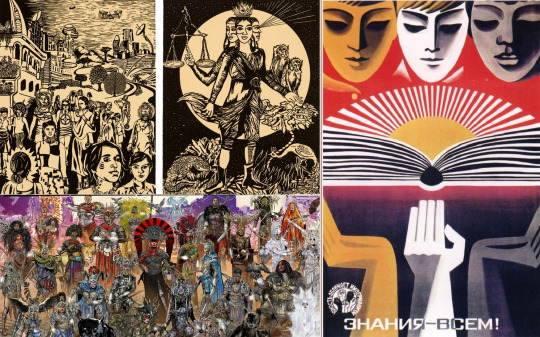
(Images counter-clockwise: cutout art representing Rokeya Sakhawat Hossain's "The Sultana's Dream" drawn by Chitra Ganesh, "Wonder Woman: Historia" by Kelly Sue DeConnick and Phil Jimenez, and a cover for Alexander Bogdanov's "Red Star")
One notable early example of Indian science fiction is Rokeya Sakhawat Hossain’s “Sultana’s Dream” (1905). Set in a future, women–dominated utopia called “Ladyland,” Sultana’s Dream is about the conflict between the women of Ladyland, who are the scientists of the country, and the men, who rebel against the women and form an army but are defeated by the science of the women and forced to retreat into purdah. A similar utopian sentiment appears in Tekumalla Raja Gopala Rao’s Vihanga Yanam (1910), in which the Indian woman Padmavati designs and creates a technologically–advanced submarine, not unlike Captain Nemo’s Nautilus, and travels to the bottom of the sea. She gathers an enormous amount of wealth from shipwrecks and uses this money to transform Indian into a techno–utopia - Women in Pre–1947 Chinese and Indian Horror Fiction and Film, by Jess Nevins
Red Star follows the journey of Leonid, a Bolshevik revolutionary who is offered the chance to go to Mars and, once there, encounters a utopian socialist society explicitly posited as the immediate, achievable future of humankind on Earth. (Bogdanov's) description of Martian society is at once located in humanity’s present and future—it is in the present day, but the Martians represent humanity’s immediate developmental end goal. Blood transfusion as a technique was one that Bogdanov not only described, but intended to implement among his own society, specifically with the intention of bringing about the socialist utopia described in his novel - Economic Circulations: Blood-Based Systems of Value in Alexander Bogdanov’s Red Star, by Virginia L.Conn
And the final one we're going with is taking a step back from the character's intent and history to laser focus on Diana as a character. Specifically, a public domain Wonder Woman, shut off from the rest of the DCU and the Justice League, and perhaps even shut off from Themyscira. Maybe for this one we can run with an angle more akin to takes where she's exiled, or something akin to the original backstory for America Chavez, who was explicitly designed to be Marvel's modern riff on Wonder Woman, where the utopian homeland was there and it matters but it's something she can't go back to, and can only carry with her as part of her dual heritage. The intent here is to push Diana closer to the knight-errant archetypes you see in pulp fiction, the cowboys and youxia / wuxia folk heroes and sword-and-sorcery wanderers striding their path across the world wherever it will take them (by no means am I suggesting sword-and-sorcery as an influence past this specific aspect, get rid of that stupid fucking sword by all means). Stripped of the superhero signifiers and context, even if still fundamentally one.
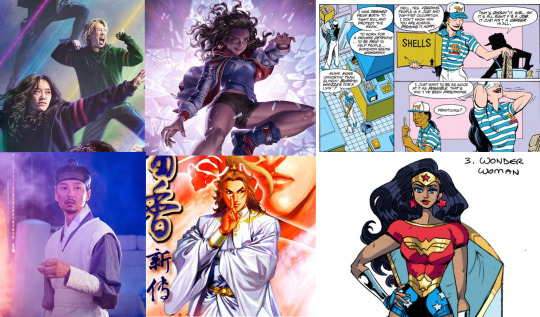
(Top images left-to-right: Do Ha-Na and Chu Mae-ok from The Uncanny Counter, America Chavez by Jung-Geun Yoon, Wonder Woman (1987) #75)
(Bottom images left-to-right: Heo Im from Live Up To Your Name, Chu Liuxiang, Wonder Woman by Mike Becker)
Wonder Woman as the Fantasy Knight-Errant Liberator. Like the pacifist take on the swordsman bandit seen in Chu Liuxiang, who only ever fights with a steel fan to block and parry attacks, robs from the rich to help the poor and solves mysteries with a cool head and a large network of friends and allies. Something like Heo Im from Live Up To Your Name, the superhumanly-skilled Joseon acupuncturist who is thrown across space and time into modern times to experience not just personal growth, but the thorough understanding of medicine necessary for him to literally write the book on it, who makes for a deeply compelling and versatile blend of cool, funny, kind and tragic as a protagonist. Or something like the Counters from The Uncanny Counter, who operate as superpowered agents of heaven in stopping and exorcising evil spirits who latch onto wicked and vulnerable humans and patching the wounds left by both, dealing with financial and social crimes and protecting victims of economic exploitation and injustice as much as they have grueling fistfights with possessed telekinetic serial killers, even to save them from themselves. Maybe some design cues from the Counters' striped hoodies or America Chavez, the dimension-hopping, star-spangled gay jock powerhouse who can go anywhere and do anything (and who suffers from the exact same problems as WW does in that they can't stop fiddling with her backstory and piling baggage that's actively detrimental to the character).
You take Diana, the teacher, redeemer and diplomat whose core strength is the concept of truth and her ability to see and expose it, who's out to dismantle all systems of violence and actively pursues social justice and forward-minded activism, who goes out looking for new experiences to better learn and understand the world around her and treats a minimum-wage gig serving tacos with unwavering and unselfconscious dedication and commitment that she uses to tackle a mythological and epic playing field.
Someone who faces forces of allegorical monstrosity and mythological metaphor and embodiments of bigotry. Someone who interfaces with politicians one hour and tends to soup kitchens in the next, who opens shelters and goes palling around with the Holiday Girls, someone who rides around on invisible jets and swims with sharks and turns enemies into friends. Someone who knows for a fact that a better way of living is possible because it's where she comes from. Take these ingredients and play around with them, modernize them, because Wonder Woman must be facing towards the future, and the intent to fashion a kinder, more loving, better one.
And hey, not only does she already have the perfect tool for the job in the lasso, but she's even got a distinct ride and animal companion to go around righting wrongs with and striding into the sunset with.
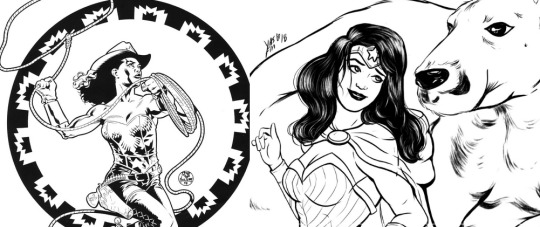
(Left-to-right: Justice Riders Wonder Woman by JH Williams, Jumpa art by Yasmín Flores Montañes)
#replies tag#superheroes#pulp heroes#dc comics#wonder woman#diana of themyscira#sci fi#diana prince#redesign
28 notes
·
View notes
Text
in between (hiding from) Big Intimidating Projects i am starting my first totally blind playthrough of Star Wars: KOTOR 1 on the Switch. I know nothing about this time period or story, but i'm liking it enough that this miiiight turn into something of a liveblog, if that's of interest to anyone.
Impressions so far, like an hour and a half in:
1. It feels VERY much like proto Mass Effect like you can just tell this is where me1 evolved from (fun fact: i first made this observation BEFORE learning that the cancelled KOTOR 3 was basically repurposed into ME1! You can REALLY feel it. I'm a relatively new Star Wars fan but huge longtime ME fan, and vibes are everywhere. On that note:
1.5 I KNEW THAT WAS KAIDAN'S VA. LOL. that man has mildly annoyed me now in THREE games. (He's better in ME3.)
2. Almost every single line is voiced including total randos which for 2003 would have been insane like I see why people lost their minds over this
3. Was not expecting zombie plague to be Big Quest 1 but I am totally here for it. Also the choice between giving the serum to nice doctor who will cure the planet for free vs. to the crime lord who will charge buckets for it..... *sniff* Ah. Timely.
4. ALSO very unexpected and somehow hilarious to me that "Sith" in this era are like. an actual... organization? culture? they have military bases and casual off-duty soldiers and shit instead of being Just Two reclusive sorcerer weirdos. Shit is SUUUUPER normalized and it's.... well. unsettlingly familiar, I suppose.
5. Ah. An Amnesiac Hero. This CERTAINLY won't lead to any Big Twists. :))))
#star wars#KOTOR#star wars KOTOR#blind playthrough#liveblog#I NEEED TO GET BACK TO WORK.... but this is a FUN brain immersion when not working
27 notes
·
View notes
Note
I know you talk about King James but how did people describe George to be? I feel like the show is going to make George out to be a helpless victim (we’ll be is a victim of his mother not James) or a fragile person who didn’t do anything wrong (already have seen be on Twitter do that) while King James might just be made out as a villain and not as complex.
Sorry for taking forever to answer, I was so busy I didn't even get to properly sit down with the trailer until now asdfkld;jsd, and also I'm not a George expert so the more devoted Buckingham enthusiasts might be able to give you a better answer
Some difficulty with trying to ascertain what George Villiers's true character was is gonna come from the fact that all contemporary descriptions of him are going to be heavily slanted depending on the agenda and factional relationships of the writer. I've been trying to find some good quotes for you but I'm limited by availability of books to me and so I'm quoting like third or fourth hand here.
There are a lot of accounts of Buckingham being monstrously ambitious, cunning, grasping. A lot of that is mixed up with anti-Catholic sentiment and depictions of Buckingham as a decadent, seductive "Ganymede" (an image that the anti-Catholics also associated with Catholicism). Many courtiers were resentful and jealous that James could only be accessed through the Great One—a position they'd rather have for themselves or one of their relatives. You'd have to be veiled with such accusations or you could be brought before the House of Lords.
In the 1620s the Spanish court was shocked at Buckingham's lack of decorum: sitting while Prince Charles stood, calling Charles nicknames, putting his feet up on chairs, performing "divers obscene things" and using "immodest gesticulations" and being "wont to move into the Princes Chamber with his Cloathes half on" (which probably does not mean literally half-naked, but rather that he did not properly dress in courtly raiment for an audience with a prince; but maybe I am wrong and it literally does mean half-naked). I think these quotes are from a 1624 letter to the English court.
At the same time that this report was being made of his character, Buckingham had a very brief moment of glory re: his public image in England because of the failure of the Spanish match, and he was being referred to as this martial, wise, brave defender of the Protestant faith. That fell apart quickly after his military failures.
However, you've also got people like Godfrey Goodman, who was specifically writing against Anthony Weldon. Weldon's The Court and Character of King James I was published as part of Parliamentarian anti-Stuart propaganda in the 1640s and was very negative on Buckingham. Goodman, writing The Court of King James the First in I believe in the 1650s, said, that "there never lived a better natured man than Buckingham", and attested to Buckingham's devotion to James and heartbreak at being accused of James's death. This is also the source of the Wikipedia quote about George, "the handsomest-bodied man in all of England; his limbs so well compacted, and his conversation so pleasing, and of so sweet a disposition", but I can't verify because I don't have Goodman's book in front of me. Of course, Goodman is just as much writing from Royalist perspective as Weldon was writing from a Parliamentarian/proto-Parliamentarian perspective.
I think something to consider is that basically no faction would find it useful to depict George as an innocent. He's either going to be a hero and competent who is James's indispensable secretary working for the good of England, or he's going to be The Evil Favorite, cartoonishly corrupt, possibly Catholic, etc.
I personally don't think that a "hapless innocent" characterization makes sense for George Villiers; he was really involved in politics, very aggressive, constantly riding back and forth between London and the hunting lodge to do business, overworking himself, etc. He had strong factional alignments but was way less of a puppet than Robert Carr (a Howard family puppet and very reliant on Overbury). It's not an invalid character interpretation for Villiers's early life, I think, but definitely by his late career he was making his own decisions.
You know, maybe these people who are trying to see innocent and passive George should stan Robert Carr instead...?
5 notes
·
View notes